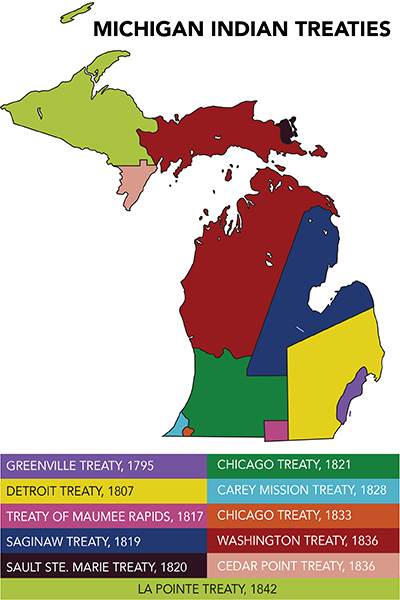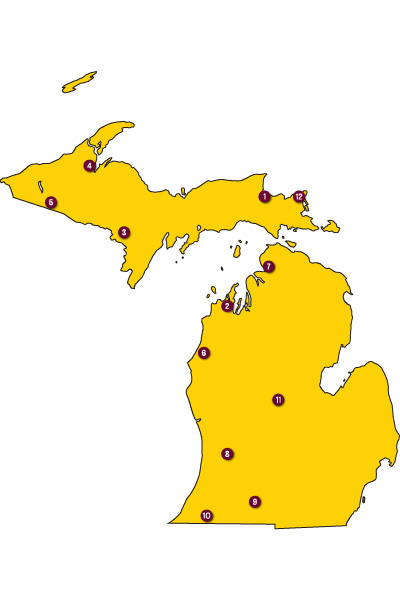Indigenous Perspectives on History and Today
Columbus’ “discovery” of America continues to be a source of amusement to most Indigenous people, who wonder how someone can discover a place already occupied by millions of people for thousands of years.

History textbooks unfortunately tend to ignore the cooperation, friendship and agreements that occurred between Indigenous nations and Europeans. These textbooks often emphasize the conflicts, which lead to the inaccurate idea that Indigenous people are particularly warlike.
If these textbooks give the impression that Indigenous history began with European contact, they also imply that Indigenous history ended in the late 1800s.
But Indigenous people have not disappeared.
- The Indigenous population is among the youngest and fastest-growing populations in the United States.
- More than 60,000 Indigenous people live in Michigan.
- Michigan is home to 12 federally recognized tribal nations as well as representatives from many other tribal nations.
Today, important issues such as tribal sovereignty, treaty rights, tribal court jurisdiction, gaming laws and tribal taxation are addressed in the nation’s courts, the U.S. Congress and state legislatures. Indigenous communities self-government precedes the Constitution and also is recognized by the Constitution and through the many treaties between the United States and Indigenous tribes.
Understand Indigenous cultural traditions
The technologies, economies, languages and political systems of Indigenous people were as diverse as their European counterparts. Indigenous peoples histories before European contact were as colorful and exciting as those of other nations. For these reasons, it is impossible to identify one Indigenous culture.
However, some beliefs and traditions are common to many nations. A special relationship with nature is an important feature of Indigenous culture, religion and society.
Most Indigenous religions/spiritual beliefs view the earth as the mother to all things. Since all creatures and plants depend on the earth for food, clothing, shelter and water, we are bound together as kin. If the earth is our mother, then all things upon her are our brothers and sisters. This relationship of respect for the environment and living in harmony with it instead of trying to dominate it is a widespread and fundamental belief among Indigenous people.
Look into the Michigan tribes
There are three major tribal groups in Michigan today: the Chippewa (Ojibwe), Ottawa (Odawa), and Potawatomi (Bodawotomi). They comprise what is called the Three Fires Council.
Although these three tribes have similar cultures and share the same territory, there still are some historical differences.
Chippewa (Ojibwe)
In Michigan, the Chippewa people occupied the eastern half of the Lower Peninsula and most of the Upper Peninsula.
Members of the Chippewa tribes:
- Used the resources of the Great Lakes as well as inland lakes, rivers and streams.
- Moved their villages to follow the fish and game.
- Developed a skill for treating illnesses using medicinal plants.
- Engaged in fur trading with the French and English and had some involvement in European colonial conflicts.
Ottawa (Odawa)
 One hallmark of Ottawa life is the birch bark canoe. In Michigan, the Ottawa people occupied the western half of the 0Lower Peninsula.
One hallmark of Ottawa life is the birch bark canoe. In Michigan, the Ottawa people occupied the western half of the 0Lower Peninsula.
Members of the Ottawa tribes:
- Were seminomadic people who walked the land and explored the Great Lakes to gather wild rice, net fish, trap both large and small game, and hunt large game such as moose, deer and caribou.
- Adapted well to the fur-trading economy through solid trading skills and craftsmanship.
- Avoided major military entanglements with the European colonial powers competing with each other for North American land and resource dominance.
Potawatomi (Bodawotomi)
The Potawatomi tribes inhabited the southwest corner of what is now Michigan in the areas of Kalamazoo and the St. Joseph River. They moved there deliberately from more northern regions to take advantage of the milder southern climate.
Members of the Potawatomi tribes:
- Shared many traits with the Chippewa and the Ottawa but lived a more sedentary lifestyle.
- Established a stable food supply and a level of political unity unusual for Great Lakes tribes at that time.
- Developed a favorable reputation for medicinal herb gardens in addition to growing the staples of corn, beans and squash.
Additional resources
- Bay Mills Indian Community (Ojibwe)
- Grand Traverse Bay Band of Ottawa and Chippewa Indians
- Match-E-Be-Nash-She-Wish Band of Pottawatomi Indians
- Hannahville Potawatomi Indian Community
- Nottawaseppi Huron Band of the Potawatomi
- Keweenaw Bay Indian Community (Ojibwe)
- Lac Vieux Desert Band of Lake Superior Chippewa Indians
- Little River Band of Ottawa Indians
- Little Traverse Bay Bands of Odawa Indians
- Pokagon Band of Potawatomi
- Saginaw Chippewa Indian Tribe
- Sault Tribe of Chippewa Indians
